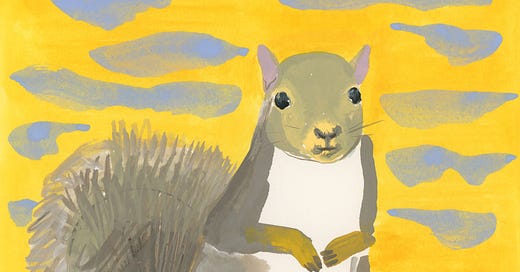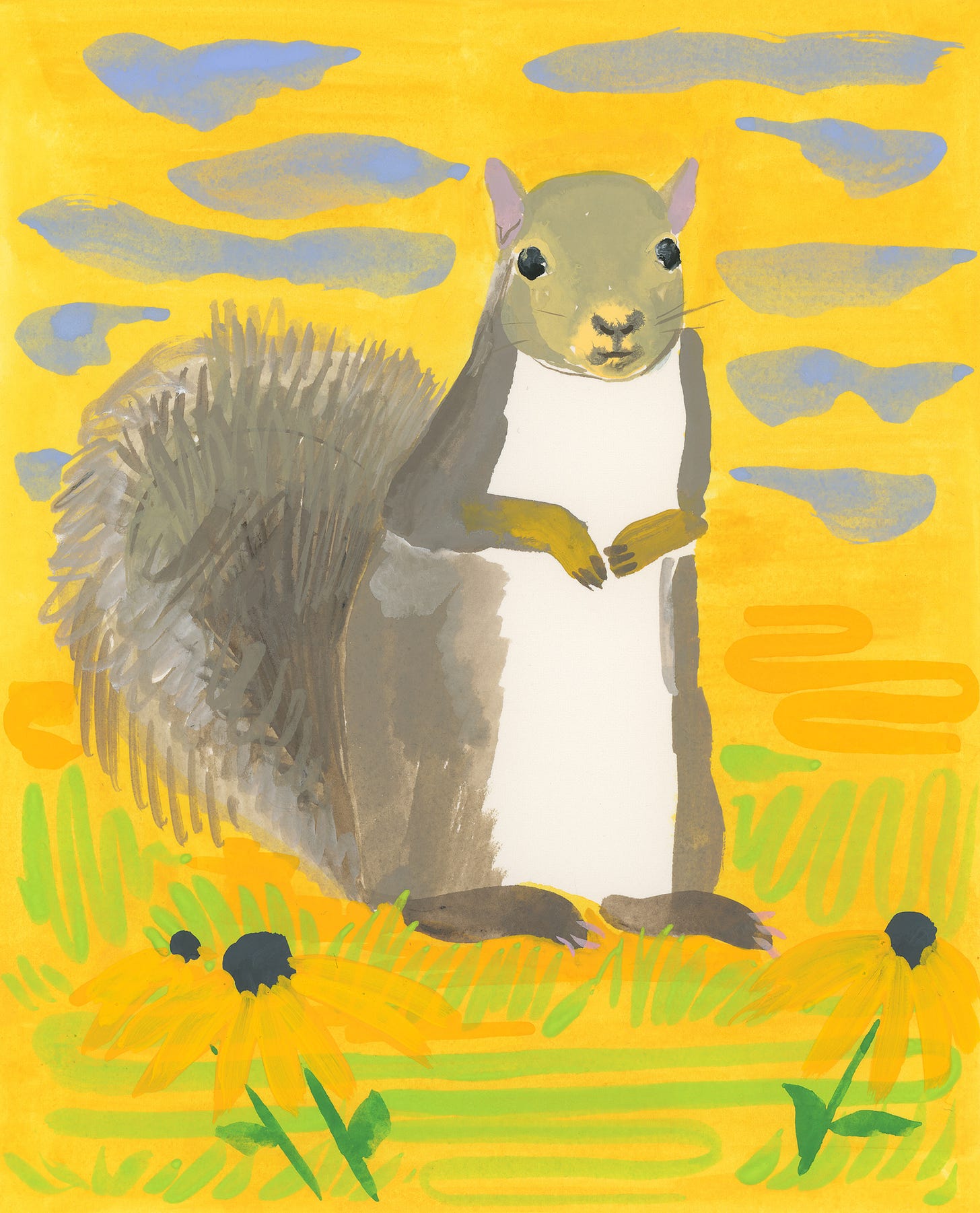Hi, friends — welcome to issue #16 of my newsletter about animal encounters. I couldn’t bring myself to draw any more winter, so here’s a burst of yellow summer out of the blue (artistic license, enjoy!). The gray squirrels (Sciurus carolinensis) make me laugh. Please share your stories, I’d love to hear. — AJP
I am dreaming of summer and it’s not even spring here in Connecticut. The snow is crusty and cold—but the squirrels are out and pulling me forward to warmer days (the sun is coming, in so many ways).
I have a soft spot for gray squirrels and their insane antics and boldness. When I first moved to New Haven from Arizona, the gray squirrel was a new species to me, and the city squirrels a whole new game. I marveled at one eating a French fry, rather politely, atop a trash can. I ran into one, literally, going full speed across a courtyard; it leapt off my knee and somersaulted ahead, no bother. I watched in amazement as two squirrels picnicked furtively under the legs of two people lunching at a picnic table.
This morning, the squirrels are out in the cold sunlight, digging at the ground under the bird feeder. They listen when I thump the window at them: paws up, ears up, puffy tails up. (The genus name Sciurus comes from the Greek skia, meaning shadow, and oura, meaning tail—a lovely bit of poetry as the squirrel sits beneath the shadow of its own tail.) At this point, after so many years, I take the squirrels for granted, though I’ve also learned not to underestimate them.
Gray squirrels have a wide-ranging diet and are resourceful and flexible thinkers. They hide and then remember thousands of buried nuts. Studies have shown that they have a strong spatial memory, and they know exactly where to find their own caches, even without scent. They will pretend to hide nuts in case any squirrel cheaters are watching (they’re always watching). Gray squirrels call to each other in the trees to warn about predators, and I’m fairly certain they have purposefully dropped acorns on my head (at least I’ve been hit by their messy acorn eating).
If you’ve ever watched a squirrel scamper down a tree you will have noticed it going headfirst—a rarity for mammals. It grips the bark by hanging from its back claws, which are turned back up the tree (this also explains how incredibly well they hang by their back toes from bird feeders). A squirrel’s claws are longer and sharper than you might imagine. The one that bounced off my knee thankfully did not grab my knee.
Gray squirrels do not hibernate but will stay in their cozy nests during the coldest weather. I never see them when it’s a real mess outside, but I do know where they live. I can see two of their nests (or dreys)—big bunches of leaves collected into tight clumps, placed high up in the oak trees. Inside these messy-looking leaf balls are some very warm, safe squirrels. This is good to know.
Gray squirrels mate twice a year, if conditions are right and food is plentiful. They prefer to raise their babies in dens, usually hollowed out spaces in trees. I like the thought of this, too: at this very moment, there are tiny warm squirrel babies filling the trees. Soon it will be baby squirrel season, when they’re all out and running, often too close and across the roads in dangerous ways. Last spring I saw a ridiculously cute pair of squirrels pop their heads out of a small hole in a tree. That was a joyful burst at an anxious moment. A year later it stands out even more.
In this early-March-gritty-cold-ice-but-also-somehow-mud season, when all I want to do is spring clean, eat fresh salads, wear sandals, see flowers and green shoots and sunshine and people again—ah, well—we’re so close, but not quite there. This is the season of almost-there. The squirrels bounding around under their own tail shadows are a first sign of new life, a promise of warmth to come. I feel their encouragement: hang in there (if only by your toes!).
Gray squirrel links—
Former NASA engineer Mark Rober designed an elaborate squirrel obstacle course. The squirrels win, of course. [YouTube]
Squirrels are made for cities because cities were made for squirrels—an interesting perspective at Atlas Obscura.
Gray squirrels were introduced to the UK and Ireland in the 19th century as pets and adapted all to easily, to the dismay of the smaller red squirrel. It seems that grays are better problem solvers. [National Geographic]
Here’s an hour’s worth of a gray squirrel eating seeds, just in case you need. [YouTube]
Animal encounters in recent comments—
Barred owl on a balcony, with photo! Thank you, Al, for all of your barred owl tales.
Also—
Next week: the tiny but tough northern short-tailed shrew
My yellow squirrel drawing is for sale; please reply if you’re interested. I’ll send some of the proceeds to the National Wildlife Federation.
Earlier this week, March 3rd, was World Wildlife Day celebrating “Forests and Livelihoods: Sustaining People and Planet.” More information at wildlifeday.org
Thank you for reading and for sharing with friends and family. This newsletter is a small weekly adventure about the life around us. If you’re new here you can subscribe for free at:






Just on the cusp of the New Year, we rented an old Victorian house in Chester, NY with it's old, Victorian oak trees. At about the same times each day, mid-morning and mid-afternoon-ish, a gray squirrel made its way around the grounds, returning to an almost perfect home in a hole along the trunk of a very old tree. In fact, he had two cozy spots, with a branch/porch in between. It would typically scurry first to the one on the right, sit for a bit on its porch, then peak into the one on the left. I imagine he had one stuffed with nuts for the winter, the other with whatever warm and soft scraps he could find. I say "almost perfect" because at the time we observed it, it had clearly been busy bulking itself up for the cold winter. While it could quickly scurry up and down the trunk, physically fitting into the hole was a challenge. But it persevered, giving a few last, strong pushes with it's feet, mid-air, to get entirely safely inside. It fit. Barely.
Having grown up on the East Coast, I never thought much about squirrels. Then, a Japanese friend of mine was visiting me at my parents' house in Massachusetts and couldn't get over her delight at seeing them. 'Squirrel' is also really difficult to say for non-native English speakers, so we got pretty giggly about her excitement and attempts to pronounce the word. Japan has some really amazing squirrels of its own, though less ubiquitous than here in the States.